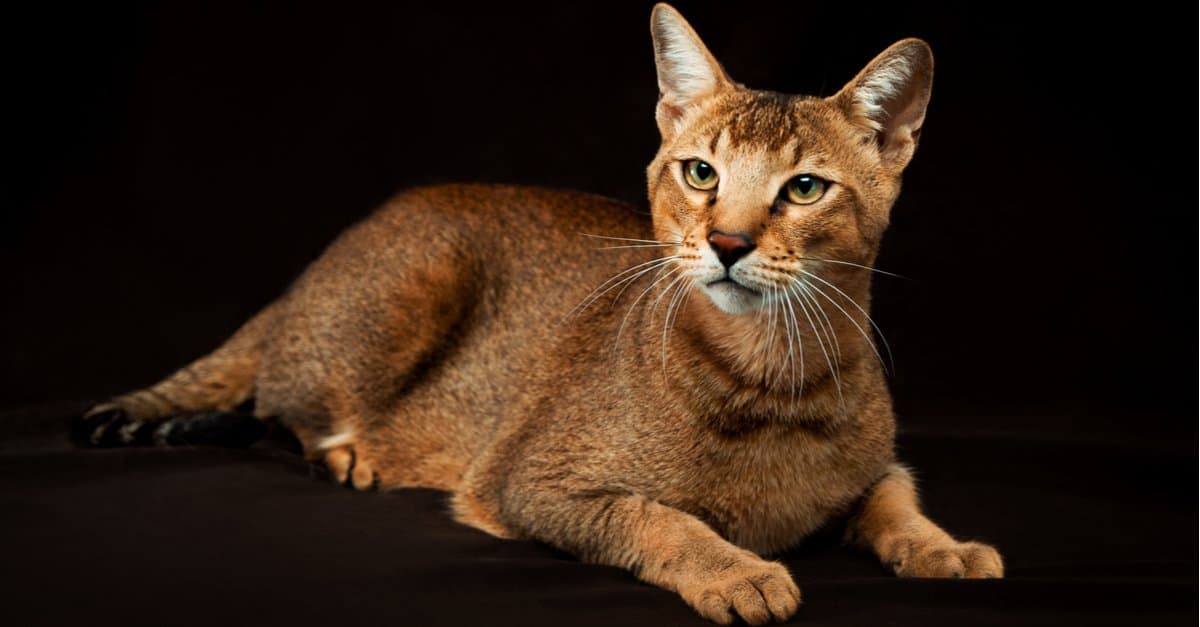With somewhere between 40 and 70 recognized cat breeds (depending on the registering organization you ask) on the market, the domestic cat has more diversity within its species now than ever before. From different coat patterns, colors, lengths, and textures to different head and eye shapes, let’s take a look at some of the most incredible types of exotic cats that you can own!
While many of the breeds on this list are hybrid breeds, not all of them necessarily have wild cat genes. Some, like the Ocicat and Toyger, are domestic breeds that have merely been bred to have an exotic appearance, while others are more closely related to jungle cats, servals, Asian leopard cats, and more.
1. Ocicat
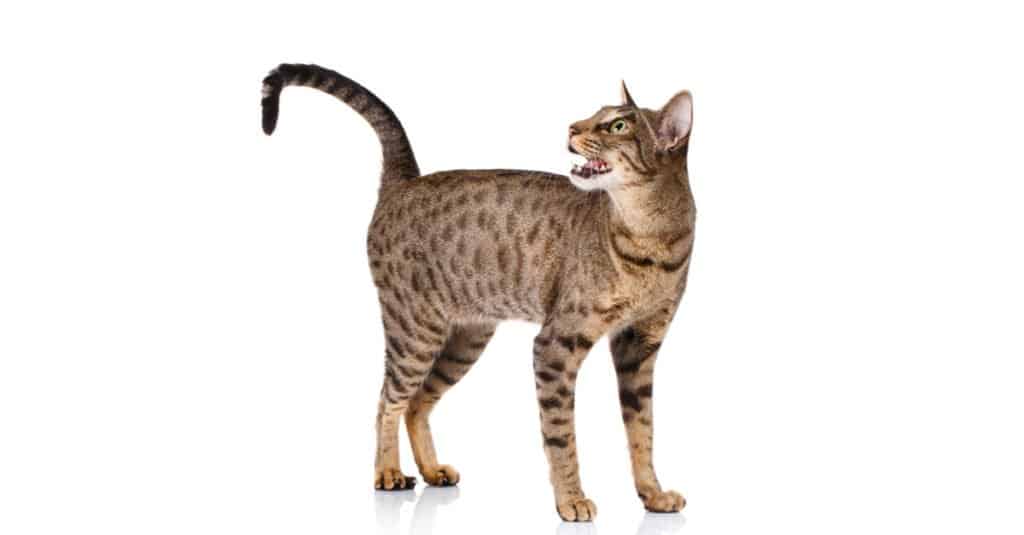
Ocicats are prized for their exotic appearance and spotted coats.
©Kucher Serhii/Shutterstock.com
Named for how closely it resembles an ocelot, the Ocicat actually has no wild cat DNA within its gene pool! In reality, Ocicats are a mixture of the Siamese, American Shorthair, and Abyssinian breeds. That doesn’t stop this unique breed from being highly coveted and prized by cat enthusiasts everywhere, though.
The first thing you’ll notice about the Ocicat is its handsomely patterned coat. In total, 12 different coat color variants are recognized by most major cat registries, but its large, distinctly round and uniform spots are always present. The first Ocicat, named Tonga, was produced in 1964 on accident by breeders hoping to get an Abypoint Siamese cat.
Despite their substantial size and athletic, muscular appearance, the Ocicat is actually very mild-mannered, loyal, and curious. These traits, along with the cat’s stunning coat and large, pronounced facial features, have solidified its presence not only at cat shows all over the world but also in the hearts of cat hobbyists.
2. Chausie
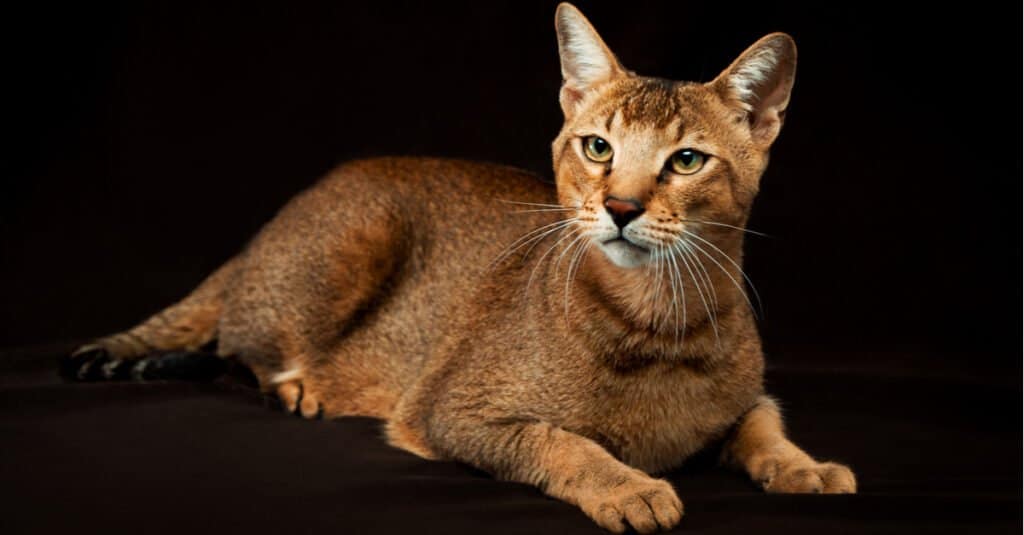
The Chausie cat’s striking facial features are thanks to its jungle cat genes.
©Tania__Wild/Shutterstock.com
As you might have guessed by its large size and wild-looking features, the Chausie is a hybrid breed through and through. Researchers believe the foundation of this breed, the result of domestic cats breeding with wild jungle cats, has existed for thousands of years! Despite this, the Chausie wasn’t truly refined by breeders or recognized by The International Cat Association (TICA) until 1995.
In terms of appearance, Chausies are large yet lean, with long legs and striking, angular facial features. Its coat is short, wiry, and dense, and TICA currently recognizes three different coat colors. These variations are brown ticked tabby, black grizzled tabby, and solid black. The Chausie’s eyes are large and round, typically either gold, yellow, or light green in color.
This type of exotic cat’s fun temperament also makes it a popular choice amongst cat owners. Highly intelligent, energetic, and curious, Chausies are a playful bunch, but they are also deeply loyal and affectionate towards their owners.
3. Savannah Cat

A blend of domestic cat and serval genes, the Savannah cat is a popular exotic breed.
©Lindasj22/Shutterstock.com
The Savannah Cat is one of the more pricey hybrid breeds, and for many good reasons! As a unique blend of African serval and domestic cat DNA, these cats are lean, graceful, and absolutely stunning in appearance. Although they are known primarily for their spotted coats and tall, wide ears, these cats are also popular for their intelligent and confident personalities.
Surprisingly, the Savannah Cat’s roots are fairly recent. The breed was originally created in 1986 when a female domestic cat was bred with a male serval. The resulting kitten had a stunning mix of serval and domestic cat traits, and other breeders quickly took notice! Eventually, after years of selective breeding and refinement, TICA finally officially recognized the breed for registration in 2001.
As you might imagine, the Savannah Cat’s temperament matches its exotic appearance perfectly. Extremely clever and active yet loyal and affectionate, these “dog-like” cats have become highly popular and have been in high demand since the breed’s inception.
4. Egyptian Mau

The
Egyptian Mau’s
spotted coat is all-natural!
©ARTSILENSE/Shutterstock.com
Although the Egyptian Mau’s spotted coat may lead you to believe it has wild genes like some of the other types of exotic cats on our list, this cat is actually more closely related to the Maine Coon, Turkish Angora, and Korat domestic breeds. There’s quite a bit of mystery surrounding the true origins of this breed. However, historians believe the breed’s ancestors were worshipped by ancient Egyptian royalty!
As their appearance suggests, Egyptian Maus are extremely athletic, with lots of lean muscle and long, flexible legs. They are by far the fastest domestic cat breed, capable of reaching speeds of over 30 mph when they break into a sprint! Active, intelligent, and vocal, Egyptian Maus make excellent pets–if you can keep up with their boundlessly energetic behavior.
Most major cat registries recognized the breed and granted it championship status in 1968, though even today, they are exceedingly rare and hard to find if you’re looking to adopt one of your own. With its naturally spotted coat and excitable yet loyal temperament, expect to spend quite a bit of time and money on acquiring one of these stunning felines.
5. Toyger
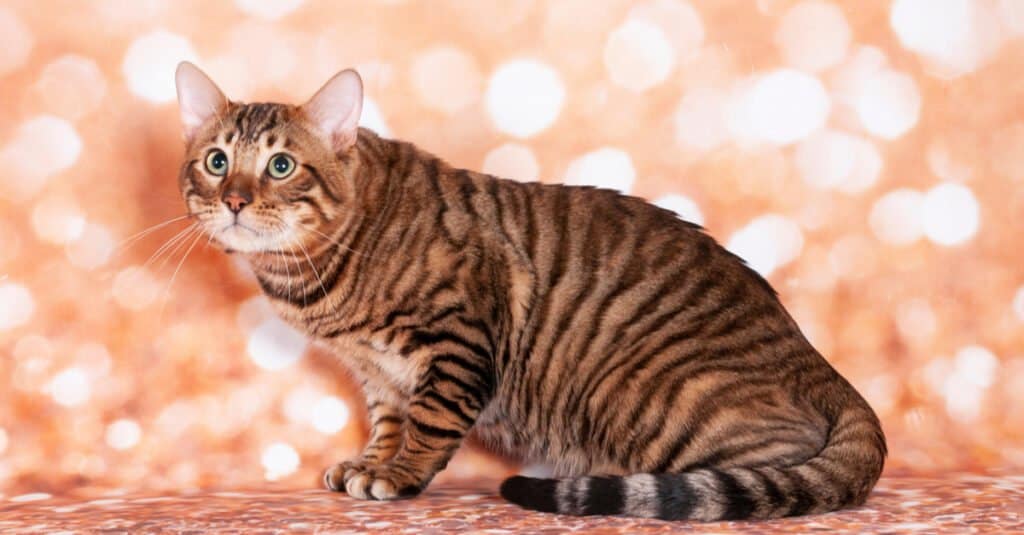
The Toyger’s striped coat is perhaps its most stunning feature.
©danilobiancalana/Shutterstock.com
With its striking striped, tiger-like coat pattern, you’d be forgiven for mistakenly thinking the Toyger has big cat DNA. In reality, though, its roots are much more mundane. The Toyger came about as the result of breeder Judy Sugden crossing various domestic tabby cats with striped “mackerel” coats in the early 1980s! Sugden created the breed mainly in hopes of encouraging cat lovers to care more about the conservation of tigers in the wild.
After several years of careful breeding, TICA accepted the Toyger breed for registration in 1993. The organization later fully recognized them as championship cats in 2007. Ever since, cat lovers have admired the breed for both its wild, tiger-like appearance and its outgoing, active, and intelligent personality.
As with any unique, fairly recently established breed, Toygers are rare. Only seven known Toyger breeders currently exist in the US. Toyger kittens typically cost upwards of $1,500 to more than $3,500 each, but if you can get your hands on one, they make wonderful pets!
6. Bengal
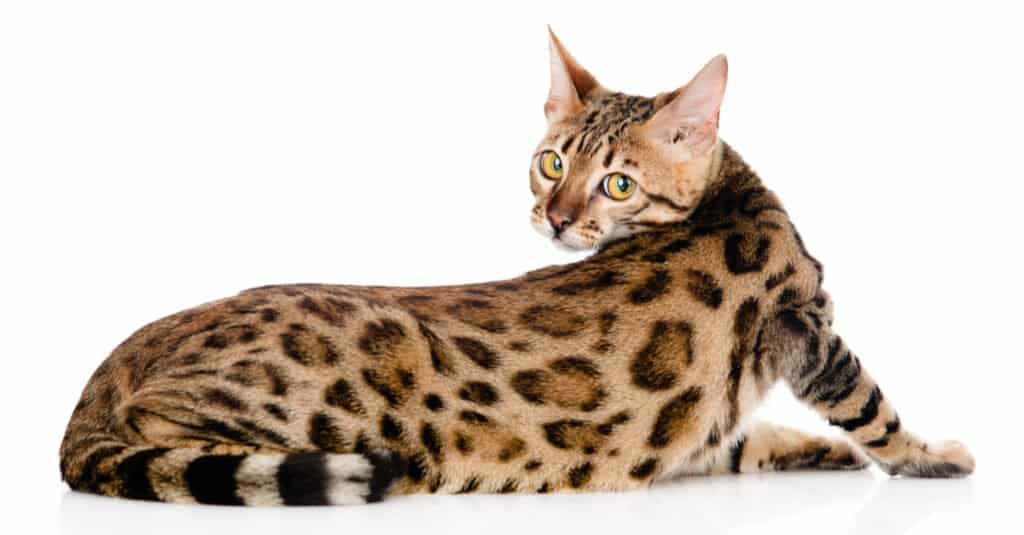
Like its Asian
leopard
cat ancestors, the Bengal cat has a handsomely spotted coat.
©Ermolaev Alexander/Shutterstock.com
As a hybrid breed, the Bengal has Egyptian Mau, Abyssinian, and Asian leopard cat ancestry. Breeder Jean Mill officially created the breed in the 1970s. However, historians have found evidence of people crossing Asian leopard cats with domestic cats as early as 1889! TICA eventually recognized this type of exotic cat in 1983 and granted it championship status in 1991. Most other major cat registries followed suit over the following decade.
The Bengal’s most striking feature is obviously its leopard-spotted coat. However, cat enthusiasts also admire the breed for its large, lean and muscular body and intelligent, energetic personality. Interestingly, like their Asian leopard cat ancestors, Bengal cats enjoy water and are strong swimmers.
Bengal cats are now available in a variety of different coat colors. Most registry organizations currently recognize four different patterns: mackerel, ticked, blotched, and spotted. Eye colors also vary, from shades of gold and green to more orange and yellow tones.
7. Serengeti
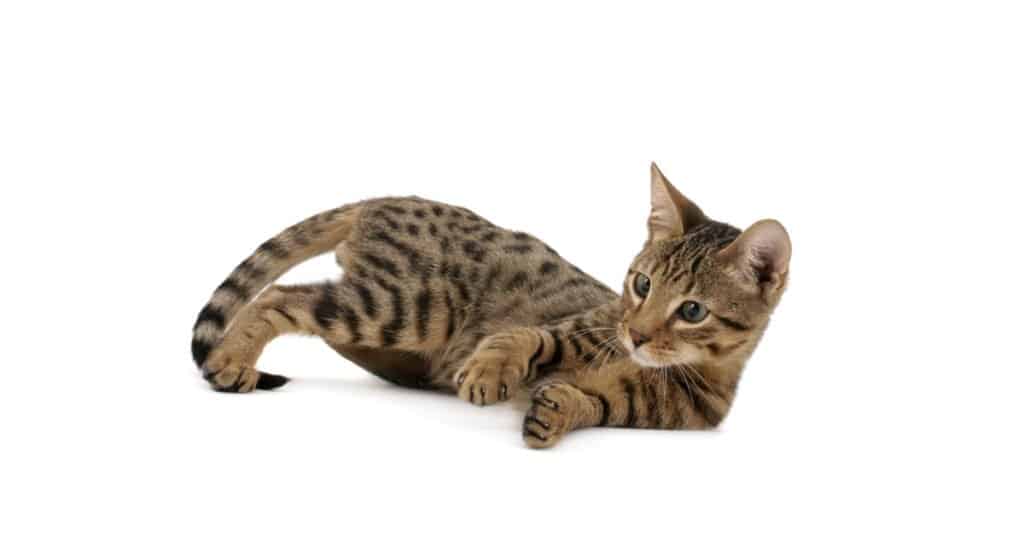
The Serengeti cat is a stunning cross between the Bengal and Oriental Shorthair breeds.
©Krissi Lundgren/Shutterstock.com
The Serengeti is a cross between the aforementioned Bengal cat and the Oriental Shorthair breeds. Breeder Karen Sausman created this breed in the 1990s in hopes of developing a cat that resembled a serval yet lacked any (recent) wild cat DNA. These one-of-a-kind cats are tall and muscular, with similarly tall, alert ears and a short, spotted coat.
While cat lovers certainly admire the Serengeti’s striking appearance, they also love the breed for its confident, friendly, and active personality. Serengeti cats are playful and chatty, and they use a range of vocalizations to communicate with their owners. They’re also speedy and athletic and will often use their strong, muscular legs to run and jump incredible distances.
Although they’re a fairly new type of exotic cat, Serengeti cats are quite popular. Though they aren’t truly a hybrid breed, they are in just as high demand! It is common for Serengeti kittens to cost anywhere from $600 to over $2,000 each.
For even more exotic cat breeds, check out our “EVEN MORE Types of Exotic Cat Breeds” page.
7 Types of Exotic Cats
| Rank | Exotic Cat | Breed Traits |
|---|---|---|
| 1 | Ocicat | Mix of Siamese, American Shorthair, and Abyssinian breeds |
| 2 | Chausie | Hybrid breed with large size and wild-looking features resulting from a cross of domestic and wild jungle cats |
| 3 | Savannah Cat | Pricey hybrid breed of an African serval and domestic cat |
| 4 | Egyptian Mau | Related to the Maine Coon, Turkish Angora, and Korat domestic breeds; worshipped by Egyptians |
| 5 | Toyger | Breed created by Judy Sugden crossing various domestic tabby cats with striped “mackerel” coats in the early 1980s |
| 6 | Bengal | Breed created by Jean Mill in 1970’s with Egyptian Mau, Abyssinian, and Asian leopard cat ancestry |
| 7 | Serengeti | Cross between the Bengal and Oriental Shorthair breeds created in 1990’s by Karen Sausman |
Thank you for reading! Have some feedback for us? Contact the AZ Animals editorial team.

